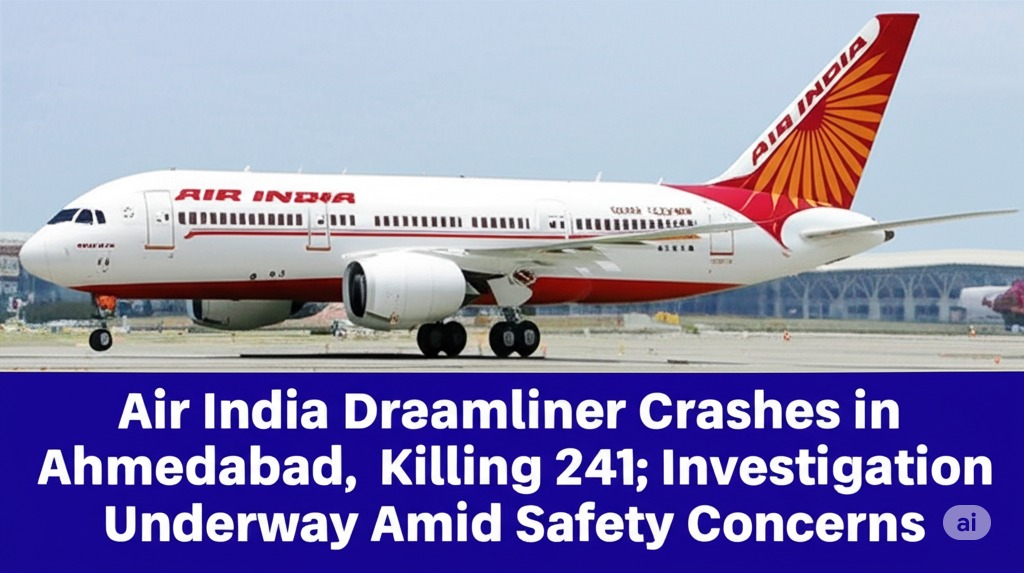Air India Dreamliner Crashes in Ahmedabad, Killing 241; Investigation Underway Amid Safety Concerns
Published on June 13, 2025 | Generated by AI
 🤖 AI-generated Image
🤖 AI-generated Image
Why It Matters
The crash of Air India Flight AI171 shortly after takeoff from Ahmedabad on June 12, 2025, is a major international tragedy, resulting in the deaths of 241 people, including passengers and crew, and impacting a residential area. This incident has immediately raised urgent questions about aviation safety, particularly concerning the Boeing 787-8 Dreamliner aircraft model, and puts aerospace giant Boeing under renewed scrutiny following earlier whistleblower allegations. Governments in India and the UK, among others, are actively involved in responding to the crisis, establishing crisis teams and pledging support for victims' families. The high fatality count and the circumstances of the crash necessitate a rapid and thorough investigation to determine the cause and prevent future disasters, highlighting the critical importance of air travel safety and the complex web of regulatory and manufacturing oversight involved.
Background & Timeline
Air India Flight AI171, a Boeing 787-8 Dreamliner, crashed on June 12, 2025, shortly after taking off from Sardar Vallabhbhai Patel International Airport in Ahmedabad, India, bound for London Gatwick. The crash marks a significant incident for both Air India and the Boeing 787 Dreamliner, an aircraft model that had previously maintained an immaculate safety record since entering service in 2011, having flown over a billion passengers. The tragedy tragically echoes past aviation disasters in India, such as an Indian Airlines crash in Ahmedabad 28 years prior in 1988. Prior to this crash, in 2024, a whistleblower named Sam Salehpour had raised concerns about alleged structural flaws and manufacturing shortcuts in the 787 Dreamliner, claims that Boeing had refuted, asserting the aircraft's safety.
What’s Happening Now
- Air India Flight AI171, a Boeing 787-8 Dreamliner carrying 232 passengers and 10 crew (242 people total), crashed on June 12, 2025, minutes after takeoff from Ahmedabad.
- The crash impacted a doctors' hostel near the airport, causing fatalities on the ground in addition to the loss of nearly all aboard the aircraft.
- Authorities initially reported no survivors but later confirmed one survivor, Ramesh Vishwakumar, found in seat 11A, who reportedly jumped from an emergency exit and is receiving treatment.
- Prominent victims include former Gujarat Chief Minister and senior BJP leader Vijay Rupani, aged 68, who was among the 241 fatalities confirmed by Air India.
- Investigations are underway, with CCTV footage showing the plane's fatal 30-second flight and veer to the left. Aviation experts are questioning factors such as the position of the landing gear and potential lack of lift or issues in the cockpit.
- International agencies, including a British agency and the US National Transportation Safety Board (NTSB), are sending teams to India to assist with the investigation. Crisis teams have been established in Delhi and London by the UK government to support affected families, including 53 British citizens who were on board.
- Tata Group, the parent company of Air India, has announced \u20b91 crore support for the families of each victim.
What Could Happen Next
-
1. Comprehensive Investigation Findings – The recovery of the black box (flight recorders) and detailed analysis by Indian and international investigative teams will be crucial. Findings could point to mechanical failure, pilot error, a combination of factors, or even external circumstances. The outcome will heavily influence future aviation safety protocols and potentially lead to regulatory actions or changes in manufacturing processes for Boeing.
2. Impact on Boeing and Air India – Depending on the investigation's conclusions, both Boeing and Air India could face significant repercussions, including legal challenges, financial penalties, and damage to their reputations. Boeing's 787 Dreamliner program could face further scrutiny, potentially impacting production or leading to temporary groundings, while Air India may need to address public confidence and operational procedures.
3. Evolution of Aviation Safety Standards – This tragic event is likely to prompt a review of existing safety standards and procedures, particularly concerning aircraft manufacturing quality control and pilot training for critical takeoff phases. Regulatory bodies in India and internationally may implement stricter oversight or require modifications to aircraft systems, potentially improving long-term air travel safety globally, although such changes can be slow and complex.
This article is generated using AI-assisted summaries and verified timelines.
